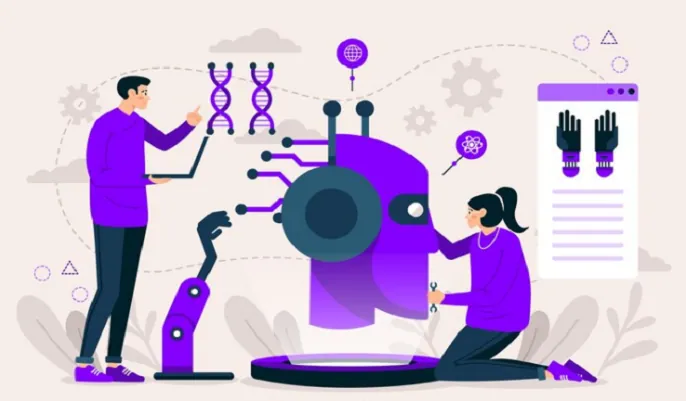AI Graphic Design
The rise of Artificial Intelligence (AI) in recent years has revolutionized numerous sectors, and graphic design is no exception. AI graphic design tools have emerged as transformative technologies, automating repetitive tasks, enhancing efficiency, and enabling designers to concentrate on innovative aspects of their work. This blog post explores the profound impact of AI on graphic design, examining how it is reshaping the industry, enhancing creativity, and streamlining workflows.
Understanding AI in Graphic Design
What is AI Graphic Design?
AI graphic designrefers to the use of artificial intelligence technologies and tools to assist in various aspects of graphic design. These tools can automate routine tasks, analyse design trends, generate creative content, and even suggest design elements based on user preferences. AI graphic design tools often integrate machine learning algorithms, natural language processing, and computer vision to enhance the creative process.
The Emergence of AI in Graphic Design
As graphic design evolves, so do the demands placed on designers. Traditional design workflows can be time-consuming, requiring extensive manual input. AI graphic design tools emerged as a solution to alleviate these challenges, allowing designers to focus on higher-level tasks while the technology handles repetitive and mundane work. Companies like Adobe, Canva, and Figma are pioneering AI-driven features that enhance the design experience, making it more accessible and efficient.
How AI is Revolutionizing the Graphic Design Process
1. Automating Repetitive Tasks
One of the most significant advantages of AI in graphic design is its ability to automate repetitive tasks. Designers often spend a considerable amount of time on routine activities, such as resizing images, adjusting colours, and creating variations of designs. AI-powered tools can streamline these processes, allowing designers to work more efficiently.
Automated Image Editing
AI graphic design tools can automate image editing tasks, such as background removal, colour correction, and image enhancement. For instance, tools like Remove.bg use AI algorithms to identify and remove backgrounds from images seamlessly, saving designers hours of manual work. This automation allows designers to focus on more creative aspects of their projects.
Template Generation
AI tools can also generate design templates based on user input or current design trends. Platforms like Canva offer AI-generated templates that users can customize according to their needs. By providing a starting point, these tools reduce the time and effort required to create designs from scratch.
2. Enhancing Design Efficiency
Efficiency is crucial in the fast-paced world of graphic design, and AI tools significantly enhance workflow efficiency. By automating repetitive tasks and streamlining design processes, AI allows designers to meet tight deadlines and manage multiple projects simultaneously.
Smart Suggestions
AI graphic design tools can analyse user behaviour and design preferences to provide smart suggestions during the design process. For example, tools like Adobe Sensei use machine learning to analyse user actions and recommend design elements that align with their style and project goals. These intelligent suggestions expedite the design process, enabling designers to create high-quality work in less time.
Collaboration and Communication
AI-powered collaboration tools facilitate communication between team members and clients. Features such as real-time editing, version control, and comment integration streamline feedback loops, ensuring that designers can incorporate changes quickly. This efficiency leads to faster project turnaround times and improved client satisfaction.
3. Empowering Creativity and Innovation
While automation enhances efficiency, it is essential to recognize that AI in graphic design is not about replacing human creativity; rather, it complements and empowers it. AI tools enable designers to focus on innovative aspects of their work, fostering creativity.
AI-Generated Art and Design
AI can create original artwork and designs, pushing the boundaries of traditional creativity. Tools like DALL-E and Artbreeder utilize generative algorithms to create unique visual content based on user input. Designers can use these AI-generated elements as inspiration or integrate them into their projects, expanding their creative toolkit.
Data-Driven Insights
AI graphic design tools can analyse vast amounts of data to identify design trends, colour palettes, and typography preferences. By leveraging this data, designers can make informed decisions about their work, ensuring that their designs resonate with target audiences. AI's ability to predict trends can help designers stay ahead of the curve and create relevant, engaging content.
The Role of AI in Graphic Design Education
As AI becomes more integrated into graphic design, it is essential for aspiring designers to understand how to leverage these technologies effectively. Online colleges, such as Oxford Home Study College (OHSC), offer AI graphic design courses that educate students on the intersection of creativity and technology.
1. Learning AI Tools and Techniques
Graphic design courses that focus on AI educate students about various AI tools and techniques. These courses cover topics such as machine learning, data analysis, and automation in design. By understanding how to use AI effectively, students can enhance their design skills and prepare for the evolving job market.
2. Exploring Ethical Considerations
As AI continues to shape the creative landscape, ethical considerations surrounding its use are crucial. Graphic design programs should address the ethical implications of AI in design, such as copyright issues, bias in algorithms, and the importance of maintaining human creativity. By fostering discussions around these topics, educators can prepare students to navigate the complexities of the AI-driven design industry.
3. Preparing for Future Opportunities
AI is reshaping the job market for graphic designers, creating new roles and opportunities. By learning about AI graphic design tools, students can position themselves as competitive candidates in a rapidly evolving industry. Understanding AI's capabilities and limitations will empower them to harness technology to enhance their creativity and productivity.
Challenges and Limitations of AI in Graphic Design
While AI offers numerous benefits to the graphic design industry, it also presents challenges and limitations that must be addressed.
1. Quality Control and Consistency
AI-generated designs may lack the human touch that defines unique and compelling artwork. While AI can produce high-quality visuals, ensuring consistent quality across different projects can be challenging. Designers must carefully curate and edit AI-generated content to maintain their creative vision and brand identity.
2. Dependence on Technology
As designers increasingly rely on AI tools, there is a risk of becoming overly dependent on technology. It is essential for designers to balance their use of AI with traditional design skills and techniques. Maintaining a strong foundation in design principles will ensure that creativity remains at the forefront of the design process.
3. Ethical Concerns
The rise of AI in graphic design raises ethical concerns related to copyright, originality, and bias. Designers must navigate these complexities and ensure that their work respects intellectual property rights. Additionally, addressing bias in AI algorithms is crucial to promote diversity and inclusivity in design.
The Future of AI Graphic Design
The future of AI graphic design holds exciting possibilities, with advancements in technology expected to further enhance creativity and efficiency. Here are some predictions for the future of AI in graphic design:
1. Continued Integration of AI in Design Tools
As AI technology advances, we can expect further integration of AI features in design software. Tools will become more intelligent, providing designers with enhanced capabilities and improved user experiences. This evolution will streamline workflows and empower designers to create innovative designs more efficiently.
2. Collaboration Between Humans and AI
The future of graphic design will likely see a collaborative relationship between humans and AI. Designers will work alongside AI tools to enhance their creative processes, using AI-generated suggestions and insights to inspire their work. This collaboration will result in a new wave of creativity that combines human intuition with AI capabilities.
3. Increased Focus on Personalization
As consumer preferences become more diverse, AI graphic design tools will enable greater personalization in design. Brands will leverage AI to create tailored experiences for their audiences, ensuring that their designs resonate with individual tastes and preferences.
4. Enhanced Training and Education
Graphic design education will continue to evolve, incorporating AI technologies into curricula. Aspiring designers will learn to leverage AI tools effectively, preparing them for a future where technology and creativity intersect. Online courses, such as those offered by OHSC, will play a crucial role in equipping students with the skills needed to thrive in the AI-driven design landscape.
Conclusion
AI graphic design is transforming the creative process, revolutionizing how designers work and interact with technology. By automating repetitive tasks, enhancing efficiency, and empowering creativity, AI tools are reshaping the graphic design industry. While challenges exist, the potential benefits of AI in graphic design are significant, enabling designers to focus on innovation and creativity.
As the industry continues to evolve, it is essential for designers to embrace AI technologies and integrate them into their workflows. By staying informed about advancements in AI graphic design and pursuing relevant education, designers can position themselves for success in a rapidly changing landscape.
For those interested in exploring the intersection of AI and various industries, Oxford Home Study College (OHSC) offers a range of free online AI courses, covering topics such as AI in education, healthcare, cybersecurity, digital marketing, and more. These courses provide a valuable opportunity to deepen your knowledge and understanding of how AI is shaping the future across multiple domains.
In conclusion, the future of creativity in graphic design lies at the intersection of human ingenuity and AI innovation. As designers leverage AI tools to streamline their workflows and enhance their creative processes, we can expect to see a new era of design that is more efficient, personalized, and innovative than ever before. The possibilities are endless, and the journey has only just begun.

